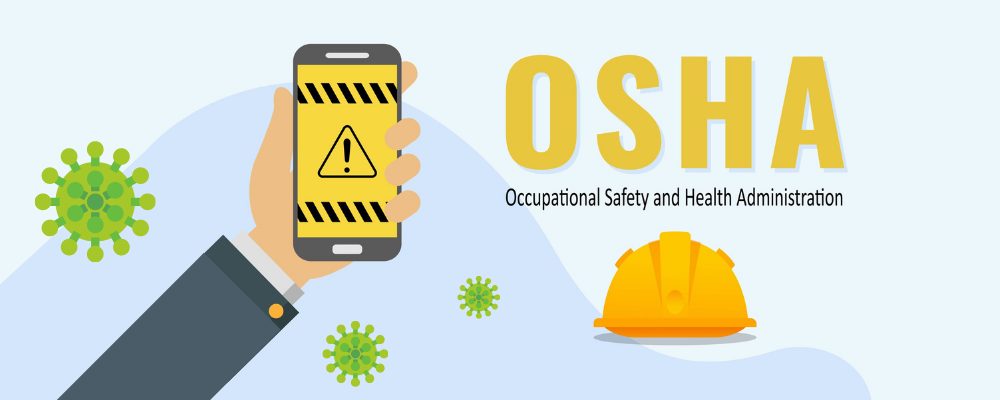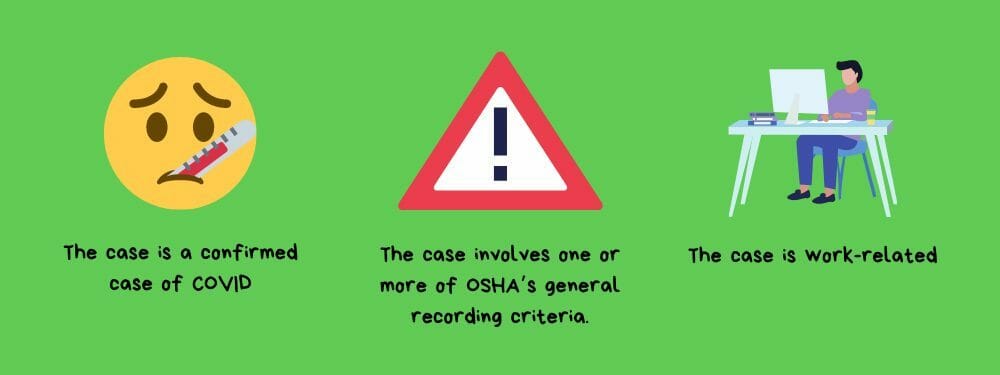Reporting COVID cases at work: Employer responsibilities
Employers are responsible to report workplace COVID cases to the Occupational Safety and Health Administration (OSHA) under certain conditions. At least 28 states also have reporting requirements that may be even more stringent than OSHA’s. Employers must know what cases require an OSHA report as well as any state requirements.
Additionally, employers must provide appropriate personal protective equipment (PPE) and track exposure to hazardous chemicals that may be used to clean the workplace. Retaliating against employees who report alleged violations is also forbidden by federal law.

When to report a workplace coronavirus case
OSHA requires employers to report COVID cases if they meet all three of the following conditions:
- The case is a confirmed case of COVID;
- The case is work-related; and
- The case involves one or more of OSHA’s general recording criteria.
Confirmed vs. Probable COVID cases
A COVID case is confirmed when a laboratory detects SARS-CoV-2 RNA in a clinical specimen using a molecular amplification detection (MAD) test. Employees merely presenting COVID symptoms are probable COVID cases until the lab performs the test. Cases where nasal swabs reveal coronavirus antigens are also considered probable until confirmed by a MAD test. The same is true of coronavirus antibodies in a serum plasma or whole blood test. Similarly, employees over 60 or with underlying health conditions who present COVID symptoms are probable cases.
Just because employers are not required to report probable cases, doesn’t mean they should ignore the case. Probable cases should be quarantined either for 14 days or until they can return to work safely. The CDC also provides guidance on quarantines. That guidance may change by the time you read this. Be sure to stay up-to-date by visiting CDC.gov.
Determining whether the COVID case is work-related
In its guidance, OSHA states employers “should not be expected to undertake extensive medical inquiries.” Employers should:
(1) ask the employee how he believes he contracted the COVID-19 illness;
(2) while respecting employee privacy, discuss with the employee his work and out-of-work activities that may have led to the COVID-19 illness; and
(3) review the employee’s work environment for potential SARS-CoV-2 exposure. In particular, employers should check with other workers to see if they have symptoms.
OSHA expects employers to make a relatively quick determination on work-relatedness. That assessment can always be changed if new evidence emerges.
OSHA acknowledges that determining work-relatedness “cannot be reduced to a ready formula.” The guidance cites, certain types of evidence may weigh in favor of or against work-relatedness. For instance:
- COVID-19 illnesses are likely work-related when several cases develop among workers who work closely together and there is no alternative explanation.
- An employee’s COVID-19 illness is likely work-related if it is contracted shortly after lengthy, close exposure to a particular customer or coworker who has a confirmed case of COVID-19 and there is no alternative explanation.
- An employee’s COVID-19 illness is likely work-related if his job duties include having frequent, close exposure to the general public in a locality with ongoing community transmission and there is no alternative explanation.
- An employee’s COVID-19 illness is likely not work-related if she is the only worker to contract COVID-19 in her vicinity and her job duties do not include having frequent contact with the general public, regardless of the rate of community spread.
- An employee’s COVID-19 illness is likely not work-related if he, outside the workplace, closely and frequently associates with someone (e.g., a family member, significant other, or close friend) who (1) has COVID-19; (2) is not a coworker, and (3) exposes the employee during the period in which the individual is likely infectious.
- Compliance Safety and Health Officers (CSHOs) should give due weight to any evidence of causation, pertaining to the employee illness, at issue provided by medical providers, public health authorities, or the employee herself.
The standard for reporting is whether the case is more likely than not to be work-related. OSHA is indicating it will be lenient on reporting issues unless the employer fails to protect workers. Whether the case is reportable or not, employers must work to contain the spread.
OSHA general reporting criteria
The third condition involves OSHA’s general recording criteria. Cases will meet the criteria if they result in:
- death,
- days away from work,
- restricted work or transfer to another job,
- medical treatment beyond first aid,
- or loss of consciousness.
The criteria go on to say employers must report any “significant injury or illness diagnosed by a physician or other licensed healthcare professional.” This is true even if it does not result in any of the criteria listed above.
The regulation’s definition of “significant” focuses on serious workplace injuries and chronic health conditions. As more people recover from COVID, doctors have found many develop chronic conditions such as myocarditis, an inflammation of the heart. Some have lung issues such as a condition labeled “ground-glass opacity.” Such chronic effects of COVID could trigger an obligation to report to OSHA.
Given the catchall category of “significant,” any employer in doubt should report to be on the safe side. The key here is to train workplace safety personnel to identify reportable COVID cases.
State OSHA Plans
In 28 states, states operate OSHA approved plans that may have more stringent requirements than the federal plan. In 22 of those states, the plans cover public and private employers. The other six states’ plans apply only to public employees. A map showing the states is available at https://www.osha.gov/stateplans/.
California’s OSHA (CalOSHA) developed a protocol for healthcare employees to prevent aerosol transmissible diseases (ATDs). It details conditions under which employees must be referred to a healthcare provider for treatment. Obviously, this would also trigger a report to CalOSHA. Employers should refer an employee who:
- Has a cough for more than three weeks that is not explained by non-infectious conditions.
- Exhibits signs and symptoms of a flu-like illness during March through October or exhibit these signs and symptoms for a period longer than two weeks. Signs and symptoms include coughing and other respiratory symptoms, fever, sweating, chills, muscle aches, weakness, and malaise.
- Confirms having a transmissible respiratory disease, excluding the common cold and seasonal influenza.
- Confirms exposure to an infectious ATD case, other than seasonal influenza.
CalOSHA also requires healthcare employers to establish written infection control procedures. Covered employers must appoint a person to head the effort. The plan must also include a list of job classifications that are potentially exposed to ATDs.
California plan as model
The CalOSHA plan for healthcare employers offers some key points for employers everywhere to model. First, someone has to be responsible for reporting COVID cases and heading prevention efforts. If no one is responsible, cases will not be reported. The same is true of prevention efforts. Failure to take prudent prevention steps will result in higher workers compensation claims. Employers may also face liability from family members and contacts who catch the virus from employees.
COVID cleanup hazards
In the process of cleaning the workplace to prevent COVID spread, employers may expose workers to hazardous materials. Employers must comply with OSHA’s Hazard Communication Standard to ensure employees handle cleaning materials safely. Similarly, employers must follow appropriate PPE standards. These standards may vary from industry to industry. For example, OSHA provides different PPE rules for the construction industry.
Pandemic as an opportunity
As horrible as the COVID-19 pandemic has been, it has illuminated the need for many workplace safety procedures. Employers have an opportunity to clean the workplace, review safety programs, and train employees on reporting procedures.







